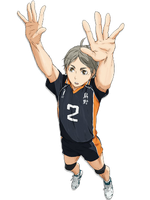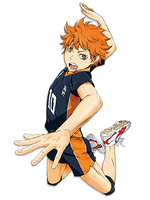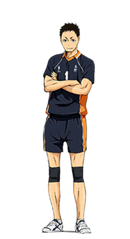A simple diagram of the location of positions and rotation numbers on the court (Note: Positions may vary depending on which team is making what play.)
There are 4 (or 5, depending on the differentiation) positions filled on every volleyball team: Setter, Wing Spiker (sometimes split into Right wing spiker and Left wing spiker), Middle Blocker, and Libero. Each of these positions plays a specific, key role in winning a volleyball match[1].
Most teams include a captain and a Vice-captain; depending on the size of the team, the captain is usually a third-year while the Vice-captain is a third-year or second-year. The captain traditionally wears the number '1' on his jersey, however, this is not always the case.
Players
Setter

Setters orchestrate the attacks. They are the playmakers of the volleyball team and are analogous to point guards and quarterbacks[2]. Their responsibilities are to run the team's attacks and build up potential scoring opportunities for the team. They aim for the second touch and their main responsibility is to place the ball in the air for the attackers to send into the opponents' court for a point[3].
They play both front row and back row; therefore they need to be able to block(defending), serve(attacking)[2]. They have to be able to operate with the spikers, manage the tempo of their team's side of the court, and choose the right attackers to set to[3]. Setters need to be able to make quick and skilful evaluations, good communication skills and tactical accuracy and must be quick enough to move around the court.
Middle Blockers

Middle Blockers are also known as Middle Hitters[3].
For defending, middle blockers are near the net in the middle of the court, between the two outside blockers. They are primarily responsible for blocks, meaning they must attempt to stop equally fast plays from their opponents and be able to quickly set up a double block at the sides of the court[3].
For attacking, middle blockers are players who perform very fast attacks that usually take place near the setter[3]. They will usually hit quick sets or serve as decoys to confuse the opponents' blockers if their passes are good enough.
For a non-beginners play, every team will have two middle blockers[3].
Libero

Liberos are exclusively defensive positions. They are responsible for receiving an attack or serve and are usually the players on the court with the quickest reaction time and best passing skills. Libero means 'free' in Italian because liberos have the ability to substitute for any other player on the court during each play[3]. However, they can't be switched in/out with the player about to serve or be switched in/out during a rally.
Liberos play in the back row. They have to wear a contrasting color compared with the rest of the team since the switch they make can be considered penalties for other positions. For a libero, height does not matter since they aren't allowed to block, spike, or play at the net. This allows shorter players with strong passing and defensive skills to excel in the position and play an important role in the team's success[3]. Due to the rules, they can't become captain either. A libero can pass a ball to a spiker, but he or she must follow specific rules; otherwise, it is a penalty.
Wing Spiker

Wing Spikers are the players who carry the serve receive responsibility along with the libero. They are usually the ones who attack the ball, which the setter sets to the antenna at either the left or right side of the court, and usually scores the most points in the game. Spikers play both the front row and the back row.
Wing spikers are generally divided into two types:
- Left Wing Spikers, also known as Left-side Hitters or Outside Hitters, attack from near the left antenna. The outside hitter is usually the most consistent hitter on the team and gets the most sets. Inaccurate first passes usually result in a set to the outside hitter rather than middle or opposite. Since most sets to the outside are high, the outside hitter may take a longer approach, always starting from outside the court sideline. For a non-beginners play, there are again two outside hitters on every team in every match.
- Right Wing Spikers, also known as Right-side Hitters or Opposite Hitters, carry the defensive workload for a volleyball team in the front row. Their primary responsibilities are to put up a well-formed block against the opponents' outside hitters and serve as a backup setter. Sets to the opposite usually go to the right side of the antennae[3]. There are two types of Opposite Hitters that teams generally use; in ordinary high school formations, the Opposite Position is given to Defensive Specialists with an overall balance play, while in professional formations, the Opposite Position is given to spikers with an overall immense Offensive capabilities, they tend to not receive or block, just attack.
Special Positions
Ace

The Ace is responsible for spiking past the blockers with brute force. The qualities of aces are high mental strength and the ability to act accordingly when cornered. The ace is also responsible for getting last point scores during long rallies where the ball doesn't hit the ground for an extended period of time.
Although an ace needs a huge amount of fighting power, being an ace doesn't really require great strength. Some aces have control rather than power and are capable of aiming in the weak spot of a blocker or making a feint spike to throw the blockers off to score.
Decoy

The decoys are responsible for tricking the defenders. They fake a spike to throw the opponents off and stall them so another teammate can take a point for the team. Some decoys have a huge amount of fighting strength or pure talent to gain the opponents attention; this makes opponents keep an eye on the decoy instead of the true spiker, tricking them in the process.
If by any chance the decoy becomes ineffective, no spiker is free and will mostly get blocked due to the blockers being able to anticipate the spiker.
Pinch Server

The Pinch Servers are switched into the game to get an advantage over the opponents or at crucial times, usually near match point. They have to perform risky serves to gain points for the team. The serves usually have to be extremely powerful or unique, such as the "Jump Float Serve".
Serve Controllers are pinch servers who have impressive control over their serves, adding rotation to the ball so that the receivers won't be able to receive the ball properly. Alternatively, they can also aim their serves (aiming in the middle of two people, or aiming to the weakest receiver) or simply curve the ball to the open area of the court.
Power Servers are another type of pinch servers who are capable of getting a service ace. Rather than relying on control, these servers rely on pure brute strength. They are capable of serves resembling spikes, as the power behind them increases their speed drastically. The ball will be so fast that the receiver will have a hard time trying to receive it. If the receiver does receive the ball, the ball will either come back to the serving team as a chance ball or it will bounce off the court.
Defense/Serving Specialist

At some levels where substitutions are unlimited, teams will make use of a Defensive Specialist in place of or in addition to a libero. This position does not have unique rules like the libero position; instead, these players are used to substitute out a poor back row defender using regular substitution rules. A defensive specialist is often used if there is a particularly poor backcourt defender in the right side or left side and the team is already using a libero. Most often, the situation involves a team using a right side player with a big block who must be subbed out in the back row because they aren't able to effectively play backcourt defense.
Similarly, teams might use a Serving Specialist to sub out a poor server[3] . Pinch servers are considered serving specialists.
Management
Coach

Coaches are the people in charge of the team. They make all the big decisions for the team, like submitting line-ups, calling time-outs, communicating with referees, etc. They are in charge of the training and building strategies for the team.
Manager

Managers are responsible for the well-being of the team. They refill the players' water bottles, help with injuries, sometimes provide food, cheer on the players, etc. They also go with the team to official matches, but only one manager is allowed to be on the bench with the players.
Teacher Adviser

Advisers are responsible for the team overall. They do not coach or take care of the players' necessities, though some advisers help arrange practice matches or buy new uniforms for the teams. Advisers' jobs are to look after the team and make sure the team is active, communicate with the school and the players' teachers, etc. They may also be teachers themselves, so they also keep track of players' academic performances.
